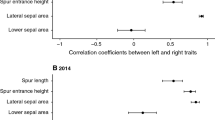Abstract
We examined the effects of floral organ size on female reproductive success in self-incompatibleErythronium japonicum. We measured tepal size and anther-stigma separation and investigated the relationship between these measurements and fruiting and seeding success. We found that tepal length was positively correlated with fruiting success and the number of seeds per fruit This suggests that pollinator attraction is affected by tepal length in f.japonicum and that the number of pollinator visits affects female reproductive success. Anther-stigma separation was the most variable floral trait measured and was not correlated with either fruiting or seeding success in this species, suggesting that the proportion of outcross pollen deposited on stigmas by pollinators does not increase with anther-stigma separation. This is inconsistent with a previous report onEtyyhtonium. grandiflorum. Pollinator size might explain this interspecific difference in the effect of anther-stigma separation on female reproductive success.
Similar content being viewed by others
Literature cited
Bell G (1985) On the function of flowers. Proc Royal Society London, B224: 223–265
Broyles SB, Wyatt R (1990) Paternity analysis in a natural population ofAsclepias exa/tata: multiple paternity, functional gender, and the “pollen-donation hypothesis”. Evolution44: 1454–1468
Broyles SB, Wyatt R (1995) A re-examination of the pollendonation hypothesis in an experimental population ofAsclepias exa/tata. Evolution49: 89–99
Campbell DR (1989) Inflorescence size: test of the male function hypothesis. Amer J Bot76: 730–738
Campbell DR, Waser NM, Price MV (1994) Indirect selection of stigma position inIpomopsis aggregata via a genetically correlated trait. Evolution48: 55–68
Campbell DR, Waser NM, Price MV, Lynch EA, Mitchell RL (1991) Components of phenotypic selection: pollen export and flower corolla width inIpomopsis aggregata. Evolution45: 1458–1467
Conner JK (1997) Floral evolution in wild radish: the role of pollinators, natural selection, and genetic correlations among traits. IntJ Plant Sci158: S108-S120
Conner JK, Rush S (1996) Effects of flower size and number on pollinator visitation to wild radish,Raphanus rephanistrum. Oecologia105: 509–516
Conner JK, Rush S, Jennetten P (1996a) Measurements of natural selection of floral traits in wild radish (Raphanus raphanistrum). I. Selection through life female fitness. Evolution50: 1127–1136
Conner JK, Rush S, Jennetten P (1996b) Measurements of natural selection of floral traits in wild radish(Raphanus raphanistrum). II. Selection through life male and toral fitness. Evolution50: 1137–1146
Darwin C (1859) The origin of species by means of natural selection. John Murray
Eckhart VM (1991) The effects of floral display on pollinator visitation vary among populations ofPhacelia linearis (Hydrophyllaceae). Evo Ecol5: 370–384
Galen C (1989) Measuring pollinator-mediated selection on morphometric floral traits: bumblebees and the alpine sky pilot,Polemonium viscosum. Evolution43: 882–890
Gaine C, Stanton ML (1989) Bumble bee pollination and floral morphology: factors influencing pollen dispersal in the alpine sky pilotPolemonium viscosum (Polemoniaceae). Amer J Bot76: 419–426
Ishii HS, Sakai S (2000) Optimal timing of corolla abscission: experimental study onErythronium japonicum (Liliaceae). Func Ecol14: 122–128
Johnson SG, Delph LF, Elderkin CL (1995) The effect of petal size manipulation on pollen removal, seed set, and insectvisitor behavior inCampanula americana. Oecologia102: 174–179
Kawano S, Hiratsuka A, Hayashi K (1982) Life history characteristics and survivorship ofErythronium japnicum: the productive and reproductive biology of flowering plants. Oikos38: 129–149
Matsui K, Ushimaru A, Fujita T (2001) Pollinator limitation in a deceptive orchid,Pogonia japonica, on a floating peat mat. Plant Sp Biol16: 231–235
Motten AF, Stone JD (2000) Heritability of stigma position and the effect of stigma anther separation on outcrossing in a predominantly self-fertilizing weed,Datura stramonium (Solanaceae). Amer J Bot87: 339–347
Murcia C (1990) Effects of floral morphology and temperature on pollen receipt and removal inIpomoea trichocarpa. Ecology71: 1098–1109
Ohkawara K, Higashi S, Ohara M (1996) Effects of ants, ground beetles and the seed-fall patterns on mymecochory ofErythronium japonicum Dence. (Liliaceae). Oecologia106: 500–506
Sokal PR, Braumann CA (1980) Significant tests for coefficient of variation and variability profiles. Syst Zool29: 50–66
Stanton ML, Young HJ, Ellstrand NC, Clegg JM (1991) Consequences of floral variation for male and female reproduction in experimental populations of wild radish,Raphanus sativus L. Evolution45: 268–280
Stebbins GL (1970) Adaptive radiation of reproductive characteristics in angiosperms. Ann Rev Ecol Syst1: 307–326
Thomson JD, Stratton DA (1985) Floral morphology and cross-pollination inErythronium grandiflorum (Liliaceae). AmerJ Bot72: 433–437
Ushimaru A, Nakata K (2001) Evolution of flower allometry and its significance for pollination success in the deceptive orchid,Pogonia japonica. IntJ Plant Sci162: 1307–1311
Ushimaru A, Imamura A (2002) Large variation in flower size of the myco-heterotrophic plant,Monotropastrum globosum: effect of floral display on female reproductive success. Plant Sp Biol17: 147–153
Utech, FH, Kawano S (1975) Biosystemtic studies in Erythronium (Liliaceae-Tylipeae). I. Floral biology ofErythronium japonicum Dence. Bot Mag Tokyo88: 163–176
Author information
Authors and Affiliations
Corresponding author
Rights and permissions
About this article
Cite this article
Ushimaru, A., Fukup, A. & Imamura, A. Effect of floral organ sizes on female reproductive success inErythronium japonicum (Liliaceae). J. Plant Biol. 46, 245–249 (2003). https://doi.org/10.1007/BF03030370
Received:
Accepted:
Issue Date:
DOI: https://doi.org/10.1007/BF03030370




